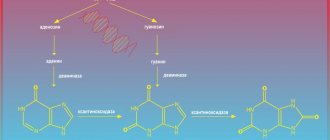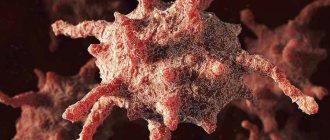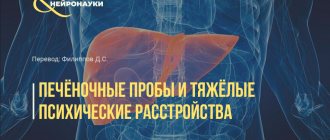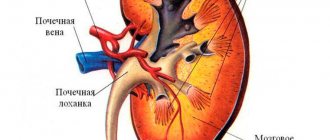You can make an appointment with a doctor by phone
8-(4822)-33-00-33
or using the online registration system on the website
Make an appointment with a doctor
Physiological reasons:
- alcohol abuse;
- a diet high in protein foods - meat, fish, poultry, dairy products, etc.;
- high physical activity.
They do not require drug treatment; behavior and lifestyle correction is recommended.
Pathological reasons:
- impaired filtration function of the kidneys;
- increased breakdown of protein in the body;
- increased levels of cholesterol, calcium and lipids in the blood;
- active breakdown of purine bases.
If physiological causes are excluded, it is necessary to conduct an examination and find out what pathology is causing the condition.
Symptoms of excess uric acid and associated diseases
The main symptoms of hyperuricemia are:
- unpleasant sensation during urination (stinging, burning, etc.);
- constant feeling of an incompletely emptied bladder;
- feverish state, feeling of chills;
- fatigue, constant weakness throughout the body;
- negative sensations in the joints (ache);
- unpleasant feelings in the kidney area (may indicate that stone formation is underway in them).
If treatment is not started in time, hyperuricemia can provoke the development of serious diseases:
- gout One of the most popular pathologies resulting from a permanently increased concentration of uric acid in the body. It manifests itself in the form of severe pain and inflammation of the joints, which is caused by deposits of salt crystals in them;
- renal failure. It occurs due to the fact that too many toxins have accumulated in the organ, and it cannot cope with their processing. If the pathology is left untreated for a long time, the patient may require dialysis and even a kidney transplant.
Possible diseases
An increase in the level of urea in the blood occurs when various organs and systems are affected.
Diseases characterized by symptoms:
- obesity;
- acute and chronic renal failure;
- arterial hypertension;
- pyelonephritis;
- oncology;
- glomerulonephritis;
- atherosclerosis;
- leukemia;
- polycystic kidney disease;
- gouty arthritis;
- nephropathy;
- urolithiasis disease.
With extensive burns, as well as with Down's disease, an increase in urea concentration may also be observed. A comprehensive examination will help to establish a diagnosis, the plan of which depends on the patient’s complaints.
Determination of urea by the urease method
Enzymatic methods are based on the hydrolysis of urea by urease in an incubation medium with pH = 6.0‑6.5 (EDTA buffer) or pH = 6.9‑7.0 (phosphate buffer) into carbon dioxide and ammonia. The resulting ammonia can be determined by a highly sensitive and specific reaction with phenol hypochlorite and the catalyst nitroprusside, by a salicylate-hypochlorite reaction, by a reaction with Nessler’s reagent (it is 10 times less sensitive compared to phenol hypochlorite, low specificity), by a dichloroisocyanurate reaction (the presence of protein interferes with the determination) .
Normal values
| Serum | (by reaction with diacetyl monooxime) | |
| newborns | 1.4‑4.3 mmol/l | |
| children | 1.8‑6.4 mmol/l | |
| adults | 2.5‑8.3 mmol/l | |
| (by reaction with Nessler's reagent) | 2.5-8.3 mmol/l | |
| (by reaction with phenol hypochlorite) | 3.3-8.3 mmol/l | |
| Urine (by reaction with diacetyl monooxime) | 330‑580 mmol/day | |
| Urine (by reaction with Nessler's reagent) | 430‑710 mmol/day | |
| Saliva | about 1.83 mmol | |
If it is necessary to compare the concentration of residual nitrogen with the nitrogen content of urea, the concentration of the latter should be divided by 2.14.
Influencing factors
- in vivo: increase - nephrotoxic drugs, corticosteroids, excess thyroxine; decrease - increase in the concentration of somatotropic hormone,
- in vitro: reduction (urease method) – sodium citrate.
Clinical and diagnostic value
Serum
The level of urea depends on the rate of its synthesis in the liver and excretion through the kidneys, as well as on the amount of protein catabolism.
Increased urea levels may occur with impaired renal function (acute and chronic diseases, urinary tract obstruction), impaired renal perfusion (congestive heart failure), depletion of body water (vomiting, diarrhea, increased diuresis or sweating), increased protein catabolism (acute myocardial infarction, stress, burns, yellow liver atrophy, gastrointestinal bleeding), with a high protein diet. In severe cases of acute renal failure, a 10-fold increase in urea levels was detected. Since the water-excreting function of the kidneys is restored faster than the concentration ability, normal excretion of urea in the urine occurs much later than the restoration of diuresis.
A decrease is observed with a low protein diet, with increased protein utilization in tissues (late pregnancy), severe liver diseases accompanied by impaired urea synthesis (parenchymal jaundice, liver cirrhosis).
When should you consult a doctor?
There are typical symptoms, the combination of which with an increased urea content indicates the possible presence of pathology. In this case, you need to consult a doctor as soon as possible.
Warning symptoms:
- joint pain;
- skin ulcers;
- decrease in the amount of urine excreted;
- arrhythmia;
- redness in the area of the knee and elbow joints;
- increased fatigue and weakness;
- episodes of increased blood pressure;
- permanent plaque on the teeth even after hygiene procedures.
If nothing worries you other than high urea levels, a visit to the doctor can be postponed for 2-3 weeks. At this time, it is worth reconsidering your habits and lifestyle. If there is no positive dynamics in the tests, it is still worth contacting a specialist. You can start with a therapist.
Determination of urea in blood serum and urine with diacetyl monooxime
The methods of this group are based on the Fearon reaction, which occurs in two stages. The first step is the hydrolysis of diacetyl monooxime to form diacetyl and hydroxylamine. In the second step, hydroxylamine reacts with urea to form a colored diazine derivative. For the oxidation of hydroxylamine, the following can be used: sodium persulfate, arsenic acid, perchloric acid, phenazone, cations. To intensify color and its stability, the following are used: thiosemicarbazide, phenylanthranilic acid, glucuronolactone, cations, tryptophan, nitrites.
Diagnostics
The examination plan depends on the patient's complaints. If you are concerned about manifestations of the cardiovascular system, you will need to consult a cardiologist. He can prescribe an ECG, EchoCG, Holter.
If there are complaints from the excretory system, the examination is carried out by a nephrologist. Additionally, determination of the level of creatinine and uric acid in the blood, as well as ultrasound of the kidneys, is prescribed.
Read also: Prostatitis in men
Complexes with this research
Check-up No. 1 for children and adolescents Annual preventive examination program RUB 10,950 Composition
Pregnancy planning. Clinical indicators 6,630 R Composition
Nutritionist recommends Metabolic status assessment RUB 7,570 Composition
IN OTHER COMPLEXES
- Kidneys. Extended examination RUR 2,040
- Kidney screening RUB 1,270
- Examination during pregnancy. 1st trimester 16,690 RUR
- Biochemistry of blood. 19 indicators 6,280 R
- Female infertility RUB 16,210
Treatment
If blood urea is only elevated, treatment is not required. But it is still recommended to adjust your habits.
Lifestyle with high urea:
- exclude alcohol;
- diet No. 6, in which the main diet consists of complex carbohydrates, and the content of purine bases is minimal;
- moderation of physical activity;
- drink at least 2 liters of water per day.
If the increase in urea concentration is caused by taking medications, you need to wait until the end of the course, wait 2 weeks and measure the level again. If there are any deviations, you should consult a doctor.
If urea levels increase due to a pathological condition, it is necessary to treat the underlying disease. Normalization of blood counts occurs when stable remission is achieved.
Dear patients! Remember that only a qualified doctor can make an accurate diagnosis, determine the causes and nature of the disease, and prescribe effective treatment. You can make an appointment with our specialists or call a doctor at home by calling 8-(4822)-33-00-33
Be healthy and happy!
What foods increase acid content?
People who have elevated levels of uric acid in the body should be extremely careful about the following foods:
- seafood. Most of them are characterized by a high purine content. First of all, these are mussels, shrimp, oysters and crabs;
- red meat. These are pork and beef, especially fatty ones. The best solution is to completely eliminate these foods from your diet.
- legumes People suffering from high urea concentrations can consume lentils, peas or beans a maximum of twice a week;
- alcohol. First of all, beer is included in the taboo list. It affects uric acid levels even worse than seafood and meat. This drink is directly contraindicated for gout.
- sweets. These include carbonated drinks, packaged juices, and sweet pastries.
Thus, it is important not to forget that high levels of uric acid in the body can lead to serious pathologies. Therefore, it is necessary to monitor its level and take timely measures to reduce it.
Clinical symptoms of increased urea in the blood
Urea in the blood is elevated in patients with severe forms of renal failure or serious pathologies of the excretory and genitourinary systems. The first sign of pathological changes, which is not always paid attention to, is a deterioration in health, the appearance of symptoms of intoxication of the body.
Characteristic is the gradual development of symptoms:
- A sudden change in blood pressure, often upward, against the background of a normal state of the cardiovascular system.
- The urge to urinate becomes more frequent, urine becomes unnaturally transparent and loses its straw color.
- With each serving, there is a gradual reduction in the volume of urine excreted;
- Swelling of the eyes, fingers and palms of the hands, feet.
- Blood tests show elevated creatinine, an indicator formed as a result of protein metabolism.
- Decreased appetite, even to the point of aversion to food.
- Dizziness, decreased activity, apathy.
- Paroxysmal headaches developing against the background of severe intoxication.
- Determination in the blood of elements characteristic of the breakdown of nitrogenous compounds - ammonia, microglobulin, acetone, oxalic acid, phenolic components.
- Dyspeptic symptoms - nausea, vomiting, diarrhea.
- A gradual increase in blood glucose levels, accompanied by cardiac arrhythmia.
Each person can independently identify signs of a critical level of urea in the blood.
A characteristic sign of high urea levels appears on the skin. Crystals of mineral salts appear on the skin, which are not eliminated along with urine. The so-called nitrogen frost appears.
Causes of increased urea in the blood
Urea in the blood is elevated against the background of underlying somatic pathology. Most often, this process is observed in diseases of the kidneys or other excretory organs.
Among the main reasons for the increase in urea levels in blood serum are the following:
- Long-term treatment with corticosteroids, cephalosporin antibiotics: Tetracycline, Lasix, Eutirox, as well as when using steroid hormone therapy. Use of androgen-based sports nutrition.
- A daily diet based on plant and animal proteins.
- Protein deficiency that developed due to prolonged fasting. A disorder of normal metabolism, during which disturbances in the functioning of the heart, kidneys, and liver develop.
- Hard physical labor, sports activities.
- Prolonged psycho-emotional stress, stressful situations, being in nervous tension.
- Acute form of renal failure. At the beginning of the development of pathological changes, a jump in the level of urea is observed, and subsequently in creatinine, reaching up to 10 mmol/l of blood.
- Malignant prostate tumors.
- Urolithiasis, neoplasms in the structure of the renal tubules that interfere with the excretion of urine.
- Pyelonephritis, glomerulonephritis.
- Complications of cardiovascular diseases, acute myocardial infarction.
- Malignant course of anemia.
- The development of thrombosis of large blood vessels that supply nutrients to the kidneys, as a result of which their normal blood supply is disrupted.
- Fluid deficiency in the body associated with prolonged thirst. In this regard, there is a disorder in the physiological functioning of the excretory organs, the elimination of decay products along with urine.
- Kidney dysfunction that has become chronic.
- Hemolytic jaundice.
- Chemical, thermal burns affecting more than 10% of the skin.
- Infectious diseases of the gastrointestinal tract, characterized by severe course, for example, cholera, typhoid fever, bacterial dysentery, botulism, salmonellosis.
- Intestinal obstruction, vascular thrombosis of the small or large intestine. In this case, the kidneys continue physiological filtration, but there is an accumulation of nitrogen-containing compounds in the blood due to a disorder of normal protein metabolism.
Pathological and non-pathological causes of increased urea in the blood.
The positive result of subsequent treatment directly depends on the rapid identification of the root cause, which led to an increase in urea levels in the general bloodstream. Restoring normal functioning of the body and stable remission is impossible without treatment of the underlying disease. Only timely diagnosis and comprehensive treatment can achieve complete purification of the blood from mineral nitrogen-containing impurities.









